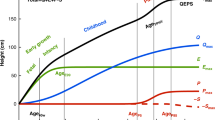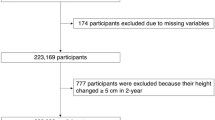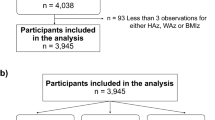Abstract
Background
The QEPS-growth-model, developed and validated in GrowUp-Gothenburg cohorts, used for developing growth references and investigating healthy/pathological growth, lacks external validation from other longitudinal cohorts of healthy individuals.
Aim
To investigate if the QEPS-model can fit the longitudinal Edinburgh growth study of another design than GrowUp-Gothenburg cohorts, and to compare growth patterns in the individuals born in mid-1970s in North-Western Europe.
Methods
Longitudinal growth data were obtained from the Edinburgh and the GrowUp1974Gothenburg cohorts. The QEPS-model was used to describe length/height from birth to adult height with confidence interval, and the multivariable regression model for estimating the contribution of the different QEPS-functions to adult height.
Results
The QEPS-model fitted the Edinburgh cohort well, with high accuracy, and low confidence intervals indicating high precision. Despite 3 cm shorter stature (less QE-function growth) in Scottish children, the growth patterns of the cohorts were similar, especially for specific pubertal growth. The contribution to adult height from different QEPS functions was similar.
Conclusion
The QEPS-model is validated for the first time in a longitudinal study of healthy individuals of another design and found to fit with high accuracy and precision. The Scottish and Western-Swedish cohorts born in mid-1970s showed similar growth patterns for both sexes, especially pubertal growth.
Impact
-
For the first time, the QEPS height model was used and found to fit another longitudinal cohort of healthy individuals other than the Swedish longitudinal cohorts.
-
With large numbers of individual measurements in each growth phase, the QEPS model calculates growth estimates with narrow confidence intervals (high precision) and high accuracy.
-
The two different cohorts born in the mid-1970s from Scotland and Western Sweden have similar growth patterns, despite a 3 cm difference in adult height.
Similar content being viewed by others
Log in or create a free account to read this content
Gain free access to this article, as well as selected content from this journal and more on nature.com
or
References
Holmgren, A. Human Growth Patterns—With Focus on Pubertal Growth and Secular Changes. Ph.D. Thesis, University of Gothenburg (2018). https://gupea.ub.gu.se/handle/2077/58087.
Hochberg, Z. & Albertsson-Wikland, K. Evo-Devo of infantile and childhood growth. Pediatr. Res. 64, 2–7 (2008).
Hochberg, Z. Evo-devo of child growth. II: Human Life history and transition between its phases. Eur. J. Endocrinol. 160, 135–141 (2009).
Gelander, L. Children’s growth: a health indicator and a diagnostic tool. Acta Paediatr. 95, 517–518 (2006).
Parent, A. S. et al. The timing of normal puberty and the age limits of sexual precocity: variations around the world, secular trends, and changes after migration. Endocr. Rev. 24, 668–693 (2003).
Aksglaede, L., Olsen, L. W., Sørensen, T. I. & Juul, A. Forty years trends in timing of pubertal growth spurt in 157,000 Danish school children. PLoS ONE 3, e2728 (2008).
Holmgren, A. et al. Nordic populations are still getting taller - secular changes in height from the 20th to 21st century. Acta Paediatr. 108, 1311–1320 (2019).
Cole, T. J. Secular trends in growth. Proc. Nutr. Soc. 59, 317–324 (2000).
Holmgren, A. et al. Estimating secular changes in longitudinal growth patterns underlying adult height with the Qeps model: the grow up Gothenburg cohorts. Pediatr. Res. 84, 41–49 (2018).
Tanner, J. M., Whitehouse, R. H. & Takaishi, M. Standards from birth to maturity for height, weight, height velocity, and weight velocity: British children, 1965. I. Arch. Dis. Child. 41, 454–471 (1966).
Prader, A., Largo, R. H., Molinari, L. & Issler, C. Physical growth of swiss children from birth to 20 years of age. First Zurich longitudinal study of growth and development. Helv. Paediatr. Acta Suppl. 52, 1–125 (1989).
Karlberg, P. et al. Physical growth from birth to 16 years and longitudinal outcome of the study during the same age period. Acta Paediatr. 65, 7–76 (1976).
Bock, R. D. Multiple prepubertal growth spurts in children of the FELS Longitudinal Study: comparison with results from the Edinburgh growth study. Ann. Hum. Biol. 31, 59–74 (2004).
Butler, G. E., McKie, M. & Ratcliffe, S. G. The cyclical nature of prepubertal growth. Ann. Hum. Biol. 17, 177–198 (1990).
Marshall, W. A. The relationship of variations in children’s growth rates to seasonal climatic variations. Ann. Hum. Biol. 2, 243–250 (1975).
Malling-Hansen, R. Perioder I. Børns Vækst Og Solens Varme, Iagttagelser (1886).
Gelander, L., Karlberg, J. & Albertsson-Wikland, K. The timing of seasonal growth is influenced by sunlight. Clin. Pediatr. Endocrinol. 3, 150–152 (1994).
Wasse. Part of a letter from the Reverend Mr. Wasse, Rector of Aynho in Northamptonshire, to Dr. Mead, concerning the difference in the height of a human body, between morning and night. Philos. Trans. 33, 87–88 (1724).
Strickland, A. L. & Shearin, R. B. Diurnal height variation in children. J. Pediatr. 80, 1023–1025 (1972).
Baker, I. A., Hughes, J. & Jones, M. Temporal variation in the height of children during the day. Lancet 1, 1320 (1978).
Karlberg, J. A biologically-oriented mathematical model (Icp) for human growth. Acta Paediatr. Scand. 350, 70–94 (1989).
Nierop, A. F. et al. Modelling individual longitudinal human growth from fetal to adult life—QEPS I. J. Theor. Biol. 406, 143–165 (2016).
Holmgren, A. et al. Insight into human pubertal growth by applying the qeps growth model. BMC Pediatr. 17, 107 (2017).
Albertsson-Wikland, K., Luo, Z. C., Niklasson, A. & Karlberg, J. Swedish population-based longitudinal reference values from birth to 18 years of age for height, weight and head circumference. Acta Paediatr. 91, 739–754 (2002).
Holmgren, A. et al. Pubertal height gain is inversely related to peak BMI in childhood. Pediatr. Res. 81, 448–454 (2017).
Karlberg, J., Luo, Z. C. & Albertsson-Wikland, K. Body mass index reference values (mean and Sd) for Swedish children. Acta Paediatr. 90, 1427–1434 (2001).
Ratcliffe, S. G., Murray, L. & Teague, P. Edinburgh study of growth and development of children with sex chromosome abnormalities. III. Birth Defects Orig. Artic. Ser. 22, 73–118 (1986).
Ratcliffe, S. G., Butler, G. E. & Jones, M. Edinburgh study of growth and development of children with sex chromosome abnormalities. IV. Birth Defects Orig. Artic. Ser. 26, 1–44 (1990).
Albertsson-Wikland, K., Niklasson, A., Holmgren, A., Gelander, L. & Nierop, A. F. M. A new Swedish reference for total and prepubertal height. Acta Paediatr. 109, 754–763 (2020).
Albertsson-Wikland, K. G., Niklasson, A., Holmgren, A., Gelander, L. & Nierop, A. F. M. A new type of pubertal height reference based on growth aligned for onset of pubertal growth. J. Pediatr. Endocrinol. Metab. 33, 1173–1182 (2020).
Holmgren, A. et al. The pubertal growth spurt is diminished in children with severe obesity. Pediatr. Res. 90, 184–190 (2021).
Saari, A. et al. New Finnish growth references for children and adolescents aged 0 to 20 years: length/height-for-age, weight-for-length/height, and body mass index-for-age. Ann. Med. 43, 235–248 (2011).
WHO Multicentre Growth Reference Study, G. de Onis, M. WHO child growth standards based on length/height, weight and age. Acta Pædiatr. 95, 76–85 (2006).
Juliusson, P. B. et al. Growth references for 0-19 year-old Norwegian children for length/height, weight, body mass index and head circumference. Ann. Hum. Biol. 40, 220–227 (2013).
Tinggaard, J. et al. The 2014 Danish references from birth to 20 years for height, weight and body mass index. Acta Paediatr. 103, 214–224 (2014).
Niklasson, A. & Albertsson-Wikland, K. Continuous growth reference from 24th week of gestation to 24 months by gender. BMC Pediatr. 8, 8 (2008).
Andersen, E., Hutchings, B., Jansen, J. & Nyholm, M. [Heights and weights of Danish children]. Ugeskr. Laege. 144, 1760–1765 (1982).
Chinn, S. & Rona, R. J. The secular trend in the height of primary school children in England and Scotland from 1972-1980. Ann. Hum. Biol. 11, 1–16 (1984).
Freeman, J. V. et al. Cross sectional stature and weight reference curves for the UK, 1990. Arch. Dis. Child. 73, 17–24 (1995).
UK-WHO Growth Charts. https://www.rcpch.ac.uk/resources/growth-charts (2012).
Grasgruber, P., Cacek, J., Kalina, T. & Sebera, M. The role of nutrition and genetics as key determinants of the positive height trend. Econ. Hum. Biol. 15, 81–100 (2014).
Engström, E., Wallgren, K., Hellström, A. & Niklasson, A. Knee-heel length measurements in preterm infants: evaluation of a simple electronically equipped instrument. Acta Paediatr. 92, 211–215 (2003).
Hermanussen, M. & Seele, K. Mini-Knemometry: an accurate technique for lower leg length measurements in early childhood. Ann. Hum. Biol. 24, 307–313 (1997).
Gelander, L., Karlberg, J. & Albertsson-Wikland, K. Seasonality in lower leg length velocity in prepubertal children. Acta Paediatr. 83, 1249–1254 (1994).
Aronson, A. X-Ray Stereophotogrammetry of Longitudinal Bone Growth. PhD thesis, Lund University (1976).
Hildebrand, H., Aronson, S., Kullendorff, C. M. & Selvik, G. Roentgen stereophotogrammetric short-term analysis of growth rate in children operated for crohn’s disease. Acta Paediatr. Scand. 80, 917–923 (1991).
Albertsson-Wikland, K., Kriström, B., Rosberg, S., Svensson, B. & Nierop, A. F. Validated multivariate models predicting the growth response to Gh treatment in individual short children with a broad range in Gh secretion capacities. Pediatr. Res. 48, 475–484 (2000).
Acknowledgements
The authors are grateful for all contributing study subjects and the study teams for the measurements, collections, and computerizing of the original growth data.
Funding
The authors acknowledge financial support from the governmental grants under the ALF agreement, ALFGBG-719041 and ALFGBG-812951 (to K.A.-W.), the Region Halland Grants (to A.H.), and the Foundation Växthuset for children (to K.A.-W.)
Author information
Authors and Affiliations
Contributions
All five authors developed the study concept and design. K.A.-W. and G.B. are principal investigators of the study populations used. A.F.M.N. performed the QEPS-analyses and made Fig. 2. A.N. made the other figures and performed the statistical analyses. A.H. made the tables and wrote the first draft of the paper. All five authors critically revised the paper for important intellectual content and approved the final manuscript to be submitted for publication.
Corresponding author
Ethics declarations
Competing interests
A.F.M.N. works for Muvara, Multivariate Analysis of Research Data, Statistical Consultation, the Netherlands. The authors declare no competing interests.
Consent statement
All study subjects and their parents or guardians gave informed written consent to participate in research studies as required by the local ethics committees.
Additional information
Publisher’s note Springer Nature remains neutral with regard to jurisdictional claims in published maps and institutional affiliations.
Supplementary information
Rights and permissions
About this article
Cite this article
Holmgren, A., Niklasson, A., Nierop, A.F.M. et al. Growth pattern evaluation of the Edinburgh and Gothenburg cohorts by QEPS height model. Pediatr Res 92, 592–601 (2022). https://doi.org/10.1038/s41390-021-01790-2
Received:
Revised:
Accepted:
Published:
Issue date:
DOI: https://doi.org/10.1038/s41390-021-01790-2
This article is cited by
-
Early life growth is related to pubertal growth and adult height – a QEPS-model analysis
Pediatric Research (2025)



